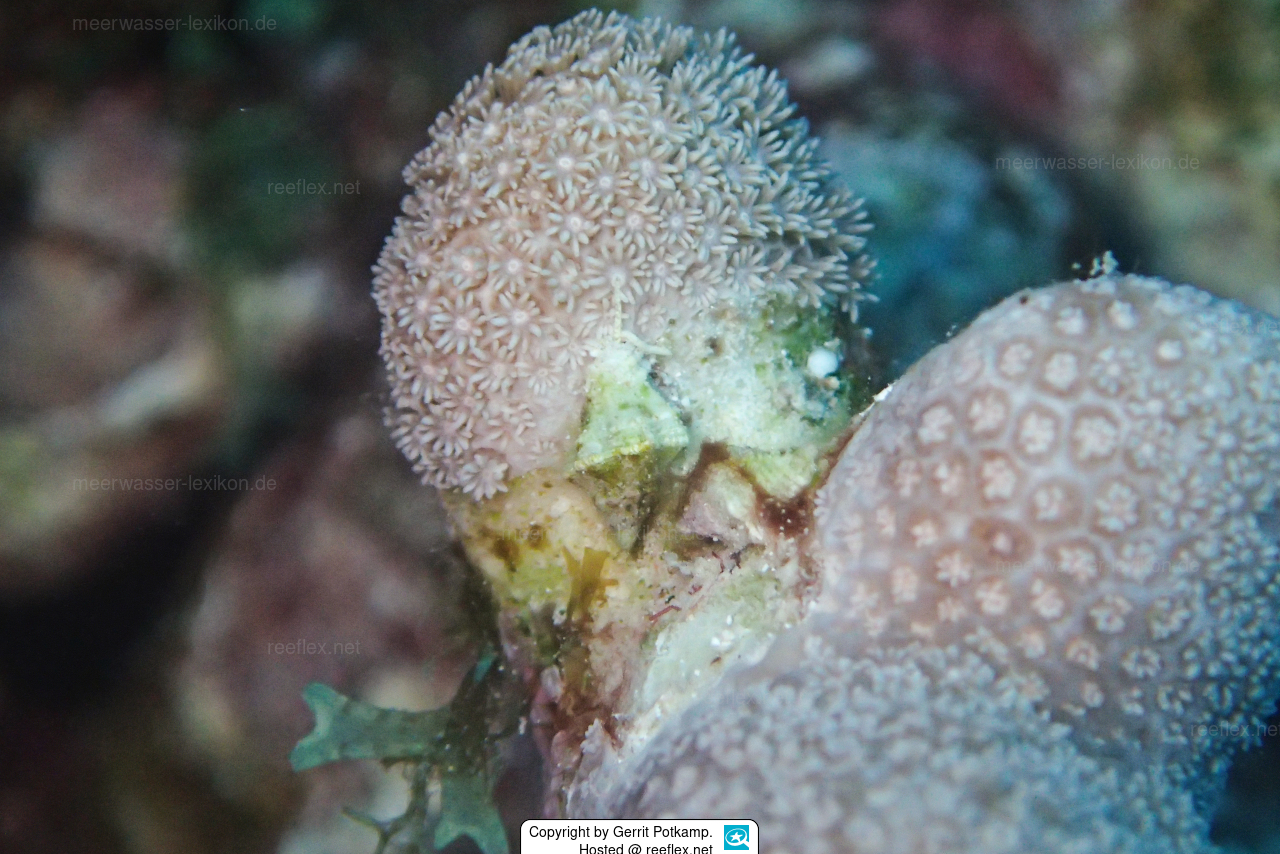Info
Coralliophila salebrosa H. Adams & A. Adams, 1864
Coralliophila curacaoensis is a coral-feeding shell snail that, as the species name suggests, was discovered around the Dutch Caribbean island of Curaçao.
The shell snail has been discovered several times on its coral host, the stony coral Madracis auretenra Locke, Weil and Coates, 2007.
Distinctive feature of the snail: the shell color is ivory white and the operculum is transparent to pale red.
Healthy coral reefs withstand a certain feeding pressure by predators, but if the populations of parasites literally explode, see also the crown-of-thorns starfish (Acanthaster planci), even vital reefs suddenly have a very big problem, because the reefs in this critical condition are additionally weakened by El Niño phenomena and human intervention (pollution, introduction of fertilizers, poisons, etc.).
However, if too many snails congregate on one coral or one colony, then it may well be the last hour for the flower animal.
With a size of not even one centimeter the snail does not seem to be a relevant threat at first.
However, the example of clearly shows the great damage the animals can cause to the tissue of a coral.
Coralliophila abbreviata is able to eat 9cm² of tissue within 24 hours.
https://cdnsciencepub.com/doi/10.1139/z72-217
Similar results should be achieved by the other Coralliophila species.
When buying new corals, please scan the canes carefully, and remove snails with the help of tweezers to avoid possible spreading to existing corals.
Etymology. Named after the island of Curaçao, the type locality of Coralliophila curacaoensis.
Literature reference:
Authors: Gerrit Potkamp, Mark J A Vermeij, Bert W Hoeksema
Genetic and morphological variation in corallivorous snails (Coralliophila spp.) living on different host corals at Curaçao, southern Caribbean
DOI:10.1163/18759866-08602002
https://www.researchgate.net/publication/317388309_Genetic_and_morphological_variation_in_corallivorous_snails_Coralliophila_spp_living_on_different_host_corals_at_Curacao_southern_Caribbean
copen access article, https://creativecommons.org/licenses/by/4.0/
Coralliophila curacaoensis is a coral-feeding shell snail that, as the species name suggests, was discovered around the Dutch Caribbean island of Curaçao.
The shell snail has been discovered several times on its coral host, the stony coral Madracis auretenra Locke, Weil and Coates, 2007.
Distinctive feature of the snail: the shell color is ivory white and the operculum is transparent to pale red.
Healthy coral reefs withstand a certain feeding pressure by predators, but if the populations of parasites literally explode, see also the crown-of-thorns starfish (Acanthaster planci), even vital reefs suddenly have a very big problem, because the reefs in this critical condition are additionally weakened by El Niño phenomena and human intervention (pollution, introduction of fertilizers, poisons, etc.).
However, if too many snails congregate on one coral or one colony, then it may well be the last hour for the flower animal.
With a size of not even one centimeter the snail does not seem to be a relevant threat at first.
However, the example of clearly shows the great damage the animals can cause to the tissue of a coral.
Coralliophila abbreviata is able to eat 9cm² of tissue within 24 hours.
https://cdnsciencepub.com/doi/10.1139/z72-217
Similar results should be achieved by the other Coralliophila species.
When buying new corals, please scan the canes carefully, and remove snails with the help of tweezers to avoid possible spreading to existing corals.
Etymology. Named after the island of Curaçao, the type locality of Coralliophila curacaoensis.
Literature reference:
Authors: Gerrit Potkamp, Mark J A Vermeij, Bert W Hoeksema
Genetic and morphological variation in corallivorous snails (Coralliophila spp.) living on different host corals at Curaçao, southern Caribbean
DOI:10.1163/18759866-08602002
https://www.researchgate.net/publication/317388309_Genetic_and_morphological_variation_in_corallivorous_snails_Coralliophila_spp_living_on_different_host_corals_at_Curacao_southern_Caribbean
copen access article, https://creativecommons.org/licenses/by/4.0/







 MSc Gerrit Potkamp, Niederlande
MSc Gerrit Potkamp, Niederlande









